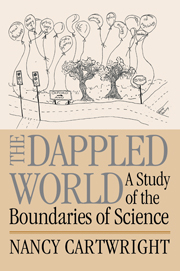Book contents
- Frontmatter
- Contents
- Acknowledgements
- Introduction
- Part I Where do laws of nature come from?
- Part II Laws and theier limits
- 4 Aristotelian natures and the modern experimental method
- 5 Causal diversity; causal stability
- 6 Ceteris paribus laws and socio-economic machines
- 7 Probability machines: chance set-ups and economic models
- Part III The boundaries of quantum and classical physics and the territories they share
- Bibliography
- Index
4 - Aristotelian natures and the modern experimental method
Published online by Cambridge University Press: 05 June 2012
- Frontmatter
- Contents
- Acknowledgements
- Introduction
- Part I Where do laws of nature come from?
- Part II Laws and theier limits
- 4 Aristotelian natures and the modern experimental method
- 5 Causal diversity; causal stability
- 6 Ceteris paribus laws and socio-economic machines
- 7 Probability machines: chance set-ups and economic models
- Part III The boundaries of quantum and classical physics and the territories they share
- Bibliography
- Index
Summary
Beyond regularity
Law-like regularities result from the successful operation of nomological machines. But what kinds of facts (if any) determine the behaviour of a nomological machine? The Humean tradition, which finds nothing in nature except what regularly happens, insists that it must be further regularities. This chapter will continue the argument that laws in the sense of claims about what regularly happens are not our most basic kind of scientific knowledge. More basic is knowledge about capacities, in particular about what capacities are associated with what features. (Or, put more laboriously, ‘knowledge about what capacities a system will have in virtue of having particular features’.) ‘More basic’ here is meant neither in an epistemic nor in an ontological sense. Epistemically, capacity knowledge and knowledge of regularities are on an equal footing – neither is infallible and both are required if we are to learn anything new about the other. And ontologically, even though reliable regularities will not come about unless capacities are harnessed appropriately, nevertheless claims about how things regularly behave in given circumstances are neither more nor less true nor more nor less necessary than claims about the capacities that explain why things behave regularly in these circumstances. Rather knowledge of capacities is more basic in that it is both more embracing and more widely useful than knowledge of regularities.
Virtue is not all on the side of capacities though. To affect the world around us we need to make reliable predictions about it and that requires regularities.
- Type
- Chapter
- Information
- The Dappled WorldA Study of the Boundaries of Science, pp. 77 - 103Publisher: Cambridge University PressPrint publication year: 1999



